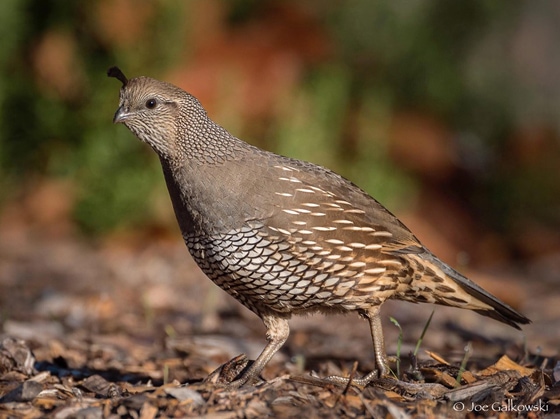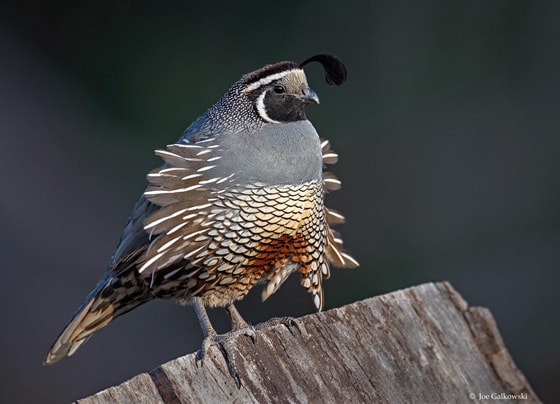Lessons from a Little Bird
Text and photos by Joe Galkowski
Well known to advertisers, safety specialists, and those who design road signs, is the psychological principle of habituation. In simple terms, if you see something enough times, and it is unchanging, it no longer gets your attention. It becomes invisible to you. Something similar happens in the wilderness.
Hiking through our local wild places, animals you see every day hardly get noticed. Where I live, California Quail are very common, and although undeniably beautiful, I pretty much ignored them. They were never a subject of my photography, probably because they seemed to be everywhere.
On a hike in June, I spotted a family of California Quail. Although these birds are very common where I live, this group caught my attention. It consisted of a male, a female, and a handful of chicks. As I walked down the trail towards them, they sprinted into the shadows of some heavily-branched shrubs, promptly disappeared from sight. Very typical behavior.

To my surprise, however, the male who was leading the group, the father of the chicks, suddenly re-emerged from the safety of the cover. This was unusual. He voiced a few warning calls and then walked further out into the sunlight in my direction. It was then that I noticed that one of the chicks had hunkered down before reaching the brush. All his/her siblings were crouching in the shadows and invisible amongst the leaves. This little guy, on the other hand, was still in the open.
While keeping his eye on me, the father quail walked back over to the little chick, quietly made the warning peep sounds they so often make, and nudged the youngster with his beak. He continued with soft peeps until the chick stood up and hopped into the shadows disappearing from sight. Before the adult followed the chick into the brush, he made eye contact with me one more time. It was almost like he shrugged his shoulders, sighed, and whispered, “…kids…”

As this was right before Father’s Day, I couldn’t help but think of what a good father this quail was. Fathers, actually all parents, occasionally need to gently nudge their children if they have strayed, warn them when they are in danger, teach them by example how to survive as adults, or guide them by showing them what options they have. It is just what fathers do. Not a bad lesson from a little bird.
Ever since this species caught my eye by doing something out of the ordinary, I have been listening for their “Chi-ca-go” calls and paying more attention to how they live.

California Quail have been our state bird since 1931. They were chosen because of their adaptability and hardiness. I suspect it also didn’t hurt that they are attractive birds with “California” in their common name.
One of the things you quickly learn while observing California Quail is their preference for running away, versus flying, from what they perceive as danger. They are pretty fast runners, too. Twelve miles-per-hour on those tiny legs is surprising. One might guess that their predilection for running is because they are weak flyers. Their plump bodies might also lead you to this conclusion. Understandable, but wrong. Quail don’t fly for long distances but their short flights can be very impressive. Quail on the wing can easily break the fifty-five mile-per-hour speed limit.

Plump doesn’t mean slow, just like common doesn’t mean uninteresting. I have enjoyed these birds the last couple of times out. I wonder how much we miss by not appreciating the everyday things while we hunt for the rare or grandiose – yet another good lesson from a little bird.
Joe Galkowski has been a wildlife photographer and a student of nature for over thirty years. As a retired, recovering engineer he can now spend more time in the wilderness watching how our local wildlife live their lives.
